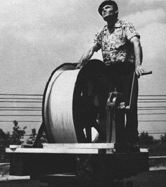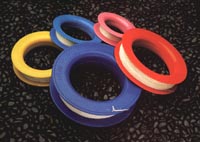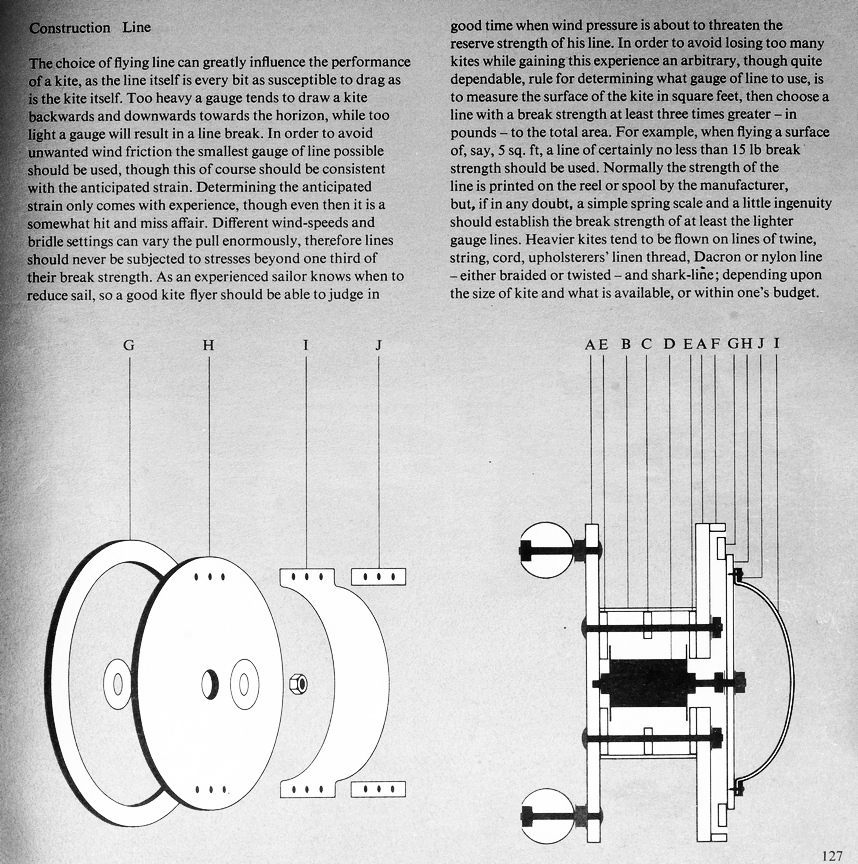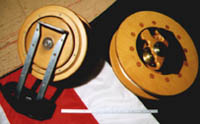
Home - Contents - Catalogs - Falconers section - Powered winch
Useful knots

 Kite flying can be a chore without some way to handle the line. In order to fully enjoy flying good kites and exploit their full potential (seeing how high you can get), decent reels are essential. The necessary kite flying skills can't be developed without being able to let line out with the right amount of drag, or take up slack quickly. Without a well balanced, free-spinning reel you can't let out line fast enough to keep up with a kite that wants to take it out in great chunks, or happens to be in a screaming dive and the only chance to stop it is to shoot out line very, very fast. Nor can you take up slack efficiently enough to maintain control when a kite suddenly falls off a thermal. Avoid like the plague any type of framice that won't spin freely, or is not balanced, or has any kind of "line guide."
Kite flying can be a chore without some way to handle the line. In order to fully enjoy flying good kites and exploit their full potential (seeing how high you can get), decent reels are essential. The necessary kite flying skills can't be developed without being able to let line out with the right amount of drag, or take up slack quickly. Without a well balanced, free-spinning reel you can't let out line fast enough to keep up with a kite that wants to take it out in great chunks, or happens to be in a screaming dive and the only chance to stop it is to shoot out line very, very fast. Nor can you take up slack efficiently enough to maintain control when a kite suddenly falls off a thermal. Avoid like the plague any type of framice that won't spin freely, or is not balanced, or has any kind of "line guide."
 Because the line stretches, a lot of stretched line will act like a powerful giant elastic or spring when one end is suddenly set free, such as when a flyer loses his grip on a knob. Reels can get to spinning very fast; the knobs will be just a blur. It may make a sound like an electric motor, and it can turn into a gyroscope on the hand. If there isn't a pair of knobs, the reel will be hopelessly out of balance and wobble out of control. It could be very dangerous. Avoid frame-type winders that, when spinning, are impossible to apply drag to or to stop without giving severe clunks. There are times when the line suddenly stops going out while the reel is still spinning, and such times are when a line guide will just create a huge mess inside the reel. I almost lost the tip of a finger from a line guide. You can't always be watching the reel for loops or other problems, and sometimes you may have to wind line on to a reel manually, which is impossible if there's a line-guide in the way.
Because the line stretches, a lot of stretched line will act like a powerful giant elastic or spring when one end is suddenly set free, such as when a flyer loses his grip on a knob. Reels can get to spinning very fast; the knobs will be just a blur. It may make a sound like an electric motor, and it can turn into a gyroscope on the hand. If there isn't a pair of knobs, the reel will be hopelessly out of balance and wobble out of control. It could be very dangerous. Avoid frame-type winders that, when spinning, are impossible to apply drag to or to stop without giving severe clunks. There are times when the line suddenly stops going out while the reel is still spinning, and such times are when a line guide will just create a huge mess inside the reel. I almost lost the tip of a finger from a line guide. You can't always be watching the reel for loops or other problems, and sometimes you may have to wind line on to a reel manually, which is impossible if there's a line-guide in the way.
Murphy's Law applies to reels, and the fewer things that can go wrong the better. The importance of smoothness and free spinning can not be over-stated. A poor finish can really take the skin off your hands while braking; some finishes (varnish is one) burn, too. Poor construction can cause any number of problems. Poor balance causes wobbling, poor quality plywood can get bent outward, poor fasteners can come loose, poor workmanship can mean knobs and axles come loose. My brother is a cabinet maker; he made me a lovely reel, but he said there was no way he could make them commercially. All the kite flyers at Kensington Gardens in London, where I got my wings, either made their own reels or got one of the ones made by Alick Pearson, Bert, or Gabriel, who knocked them out at home with a coping saw, using a dresser drawer for a workbench (I'm pretty sure he didn't even have a jigsaw). Gabriel advocated French Polish as a finish, because it didn't burn the hands under braking like varnish does; Alick had stopped making reels before the mid '70s, and Bert only made a small number (3 or 4).
 Deep sky reels have to be well designed and made because they can have so much pressure build up from line tension that they're liable to get crushed, and the sides may bulge outwards at the same time, preventing them from turning.When there's a reasonable pull on the flying line, it stretches a certain percentage, and this stretch builds up a compressive force which can reach up to 8 tons. Light line can be worse for this than heavier line; it might have stretched more, plus there are many more turns of it on a reel. Shown here is an example of what tension build-up can do to plywood.
Deep sky reels have to be well designed and made because they can have so much pressure build up from line tension that they're liable to get crushed, and the sides may bulge outwards at the same time, preventing them from turning.When there's a reasonable pull on the flying line, it stretches a certain percentage, and this stretch builds up a compressive force which can reach up to 8 tons. Light line can be worse for this than heavier line; it might have stretched more, plus there are many more turns of it on a reel. Shown here is an example of what tension build-up can do to plywood.
 If one doesn't happen to have access to deep sky reels,
or doesn't want to make them, or doesn't want the extra weight to carry, there
are some pretty good alternatives. I use Hoop Spools whenever I need to travel light, which is pretty often these days, since my backyard flying field was made into a bypass road and the place I fly now is 3/4 of an hour walk away. (Also I discovered last summer that my lowest two spinal vertebrae have a gaseous space where the intervertebral disk used to be.) You can let line out almost as well with these as with a proper reel, but winding in is obviously nothing like as efficient.Nevertheless, you can take in quite a lot with each turn. There is a warning: if you allow tension to build up on one of these, it can crack in two. The rule is to take up the tension with your arm, and not transfer it to the spool.
If one doesn't happen to have access to deep sky reels,
or doesn't want to make them, or doesn't want the extra weight to carry, there
are some pretty good alternatives. I use Hoop Spools whenever I need to travel light, which is pretty often these days, since my backyard flying field was made into a bypass road and the place I fly now is 3/4 of an hour walk away. (Also I discovered last summer that my lowest two spinal vertebrae have a gaseous space where the intervertebral disk used to be.) You can let line out almost as well with these as with a proper reel, but winding in is obviously nothing like as efficient.Nevertheless, you can take in quite a lot with each turn. There is a warning: if you allow tension to build up on one of these, it can crack in two. The rule is to take up the tension with your arm, and not transfer it to the spool.
 Similar to the Hoop Spools are the Shantitm Yo-Yo spools. Originally made for fishing, they are asymmetrical; one side flange slants outwards which allows line to spin off if you lie them down flat or turn them sideways. They look pretty strong, too. I like using them, but if the kite suddenly tugs hard the line can fly off uncontrollably, and they're more awkward to use for winding in.
Similar to the Hoop Spools are the Shantitm Yo-Yo spools. Originally made for fishing, they are asymmetrical; one side flange slants outwards which allows line to spin off if you lie them down flat or turn them sideways. They look pretty strong, too. I like using them, but if the kite suddenly tugs hard the line can fly off uncontrollably, and they're more awkward to use for winding in.
To my knowledge the only deep sky reels being made today are experimental, i.e. one-offs or a small batch of two or three. The "8 inch Deep Sky Reel" from Into the Wind, in Boulder, Colorado, USA, may not being made any more. This reel is very nicely balanced. It's an almost perfect replica of one of Gabriel's reels from the Round Pond in Kensington Gardens, Hyde Park, London, from the 1970s. They're not too big and they're not too small. They may be available second hand.

The finish is nice and smooth and so is its spinning - it is so perfectly made there is no detectable wobble when it spins. The gap between the hand plate and the moving spool is protected, as on Gabriel's originals, with a thin plywood disk to keep the line from inadvertently winding around the hub inside.
One of the nuts securing a knob had been lost from the reel in the photo, and a replacement with American standard threads hadn't been found, so the screw head visible at the top appears loose. That's because it is. With all such reels, it's best practice to carry the necessary tools - a wrench or two and a screwdriver, perhaps - in case something works itself loose in the field. Most likely candidates are the main nut holding the hand plate and the nut inside. If the inside nut works loose, the reel can jam up solid. Like a bicycle, it's best to adjust and set these carefully—not too tight!— before using them for the first time. We found that out the hard way to a chuckling chorus of "We told you so's" back in the mid-'70s at the Round Pond.
Here are two exploded views of an early (1960s to early 1970s?) Gabriel deep sky reel as drawn by David Pelham in his Penguin Book of Kites. Although this looks like one of Gabriel's reels, and I was told that someone from Parliament Hill came down to the Round Pond, asked a lot of questions about reels, and possibly borrowed one. It could have belonged to one of the other flyers. Each flyer's own reels had his own little recognizable personal quirks. Alick Pearson, for example, used 6 through bolts instead of four. All the other flyers agreed that it was a mistake to fit them tight against the inside of the plastic pipe, because when the plastic pipe would deform under pressure, it bent the bolts and led to an early and more severe collapse. Gabriel had learned to give them a little clearance and I have to say that I have an Alick Pearson reel that had collapsed in just that fashion (that happened before it came into my possession; it has been repaired, but the two drum ends are still deformed - they'd been made from a discarded formica table top found in a dumpster - it's the red one in the photo at top right).
 |  |
The main difference between the reel in the drawings and one of Gabriel's is Part "G," the plywood ring "G" fixed to the inside of the hand plate, disc "H." Despite of the parts list saying disk H is 7-ply plywood like the two main discs "A," it is shown proportionally much thinner in the drawing. And part "F" is shown as a thin ring, not at all like one on an actual reel. Here is a close-up of a Gabriel reel from the early 1970s.  H and F are the same thickness as A. F is wider than shown above, and bonded to A. It looks like one thick piece. Together they form the primary braking disc. G is only about an eighth of an inch thick. It is bonded to the inside of the handplate H, and is recessed relative to F.
H and F are the same thickness as A. F is wider than shown above, and bonded to A. It looks like one thick piece. Together they form the primary braking disc. G is only about an eighth of an inch thick. It is bonded to the inside of the handplate H, and is recessed relative to F.
If I have any comfortable webbing on hand, I sometimes change the webbing on a reel to suit. I learned from Thorsten Schacht in Copenhagen how to use two overlapping strips of thick, stretchy webbing, attached at one end only and adjusted with Velcro® for a perfect, comfortable fit. Sometimes people put a pad under where the heel of the hand rests, and some people use thin, flat nuts for the main nut under the palm of the hand, or replace the center nut with a domed one. Some flyers add some sort suitable handle to grab on to; it's a personal choice, easily done, but be careful not to have it stand too tall, causing you to bend your wrist awkwardly.
Make sure there is a pair of winding knobs on any reel; without a pair, a reel will wobble uncontrollably when a kite is taking line out fast and spinning really fast. Short round knobs are preferable to protruding handles, because when a sudden hard tug pulls a knob out of your hand, the reel will spin around and clunk you with an almighty whack if the handles are sticking out, and the damage can be even worse if the bolt ends are exposed. You have been warned.
Another thing to watch out for on a deep sky reel is that there is no gap between the fixed part and the rotating part for the line to sneak down in to when you least expect it. Gabriel went to a lot of trouble to make an extra piece of thin ply to cover this gap, and there is good reason why. Some commercial reels are sold with no covering whatsoever over the axle, and it only takes once over the side to grind a weak spot in the line or wind multiple turns of line around the axle. Also, avoid reels made with a curved core or hub, as these are guaranteed to cause birds' nests and line jams unless enough line is left on the reel to keep a level surface on the line. You will be watching the kite, not the reel most of the time, and should wind line on level without having to watch it constantly.
 In an emergency it might be necessary to drop the reel suddenly, so avoid any contraption that's somehow attached to your person in such a way that it can't be dropped quickly. In the photo here the straps on both reels are closed with quick-release velcro.
In an emergency it might be necessary to drop the reel suddenly, so avoid any contraption that's somehow attached to your person in such a way that it can't be dropped quickly. In the photo here the straps on both reels are closed with quick-release velcro.
There are a few practical things it's good to know about deep sky reels before taking one out into the field for the first time. In fact, if you've bought one with a bicycle hub as a core it may be advisable to disassemble it and put it back together again, because inside it there are cones that may need adjusting and locking nuts that might need tightening and/or repositioning. The gap between the hand plate and the spool mustn't be too close, or the spool might catch on the hand plate as it turns; the gap mustn't be too big, or the line might get wound around the axle. I have found that large diameter washers help make the hand plate more rigid on the axle. Back in "the old days" at the Round Pond I learned through bitter experience to always bring along a wrench or spanner the right size for my reels. (Curiously, since then I've not had a single problem with any of my reels!)
I remove all line guides from reels. I almost lost a finger to one once. There are times when you want to give the reel a good spin, and the guides just get in the way. Also, there may be times when it's necessary to wind the line on by hand. Guides are a nuisance when the reel has been spinning fast and the kite suddenly stops taking out line. The reel keeps on spinning with its own inertia, which allows huge loose loops of line to form, inevitably jamming the reel with a sudden crump. The best way to avoid birds' nests on reels is by winding the line on evenly with a back and forth motion that can be done without looking.

Maurice Sawyer, a kite flyer retired from the timber industry, designed some smooth running wooden deep sky reels with no ball bearings at all. The hub is built around industrial nylon bearing material. Spools can be quickly switched on the hand plate by the removal of a single circlip. These reels are exquisitely smooth, and I am lucky to have one. Maurice only made a small number of them.
In the falconry section, there is a nylon spool which may soon be made in a hand-held version, for regular kite flyers. This reel runs on roller blade bearings, which never need adjusting - which is to say they'll never come loose when you're using the reel.
Regardless of what reels or winders you use, or what kind of line, bear in mind they won't be any stronger than the weakest links - the knots. It pays to do some digging to find and learn a few good, handy knots. Fishermen have an arsenal of favorite knots, but for the rest of us a good little knot book is a most useful reference. Be sure to use one that indicates the relative strengths of the various knots, and look for knots between 90 or 95 and 100% efficiency. Many common knots actually weaken the line by as much as 50% or more. Kite lines eventually develop weak spots; always be on the lookout for signs of wear or damage: frayed fibers, pronounced kinks and surface abrasion. Along the line's length, these can be cut out and repaired very quickly in the field with a Blood Knot or Double Grinner, while worn lengths at the ends can be periodically chopped out, and the swivels re-tied.
Home - Contents - Catalogs - Falconers section - Powered winch